Machine Learning - Lecture 8: Decision trees
Chris Thornton
Introduction to bias
Modeling involves finding and representing patterns in the
data.
This means deciding what sort of pattern to look for,
and how to represent it.
Learning methods always have a bias towards certain
forms of pattern and representation.
A bias that is very specific is said to be strong.
Otherwise it is weak.
Because strongly biased methods are more focussed, they tend
to be faster.
Weakly biased methods are more general.
The problem of bias-mismatch
A common problem in machine learning is bias
mismatch.
This happens when the learning method is biased towards
the wrong form of pattern, i.e., a form that does not
feature in the data.
The result can be extremely bad performance in training or
testing, or both.
Clustering methods
Clustering methods look for patterns which take the form of
(hyper-)spherical groupings of similarly classified
datapoints.
This is a common form of regularity.
But there are many contexts in which it is not seen.
Applying clustering methods in such cases is likely to be
ineffective.
Demo
Demo involving ebaySales data with k-means clustering.
Ebay-Sales dataset
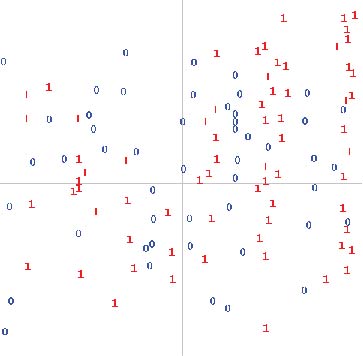
Rectangle structure
In the ebay data, we see data bunching-up in
rectangular patterns.
This happens whenever specific values
are significant in the classification of datapoints.
The effect is highly likely in categorical data.
It's also likely with numeric data whenever there are
significant ranges or threshold values.
The wrong way to sort out bias mismatch
Applying centroid-based methods to data exibiting
non-spherical forms of patterning, we have a bias mismatch
that guarantees unsatisfactory results.
If we're not aware of what's going wrong, though, we may
assume the answer is simply to increase the representational
power of the method, i.e., increase the number of centroids.
The outcome can be then be confusing.
As we get closer to the situation of having one centroid per
datapoint, performance on the training set improves.
But performance on testing data stays the same.
The `lookup table' effect
If we take this approach far enough, we end up with
one centroid for each datapoint.
Performance on the training set is perfect.
But generalization is likely to be no better than would be
achieved by random guessing.
We've fully replicated the data within the model.
The model then works as a kind of `lookup table' for the
data.
Decision-tree learning
Methods that are better suited for rectangular patterning
are the decision-tree methods ID3, C4.5 and CART.
These incrementally construct a decision-tree, by
repeatedly dividing up the data.
The aim at each stage is to associate specific targets
(i.e., desired output values) with specific values of a
particular variable.
The result is a decision-tree in which each path identifies
a combination of values associated with a particular
prediction.
The effect achieved is representation of rectangular
patterns.
Worked example
The data represent files on a computer system.
The task is to derive a model for virus identification.
Possible values of the CLASS variable are `infected', which implies the
file has a virus infection, or `clean' which implies that it doesn't.
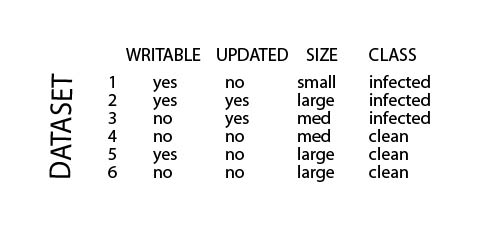
Initialisation of tree
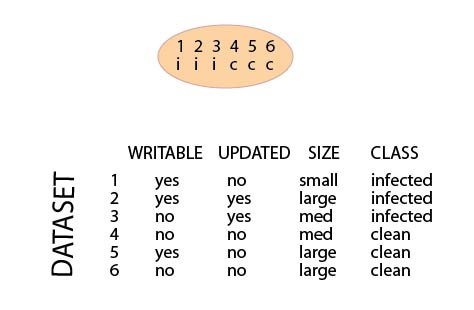
Evaluating possible splits

Selecting the optimal split
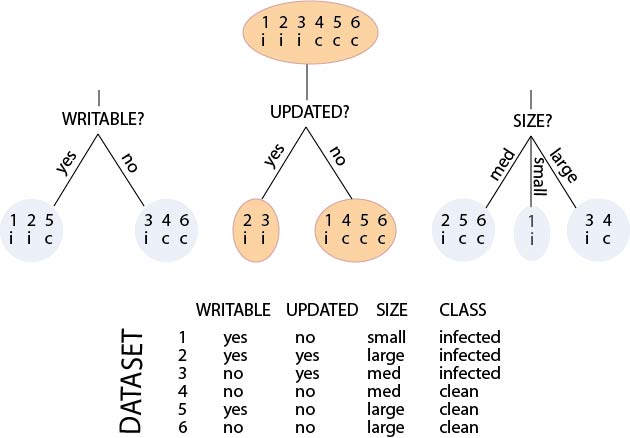
Creation of a terminal node

Finalised decision tree
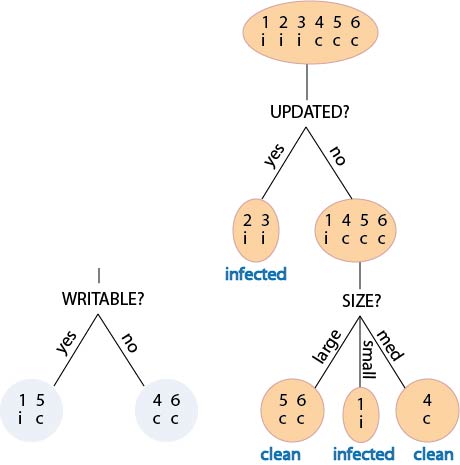
Derived rules and implied facts

Decision-tree algorithm
- Define the initial node of the decision tree to be the set
of all data. Label it `unfinished'.
- Exit if there are no unfinished nodes.
- Find the variable which best splits the data according to
class value.
- Divide the data up into subsets accordingly, creating a
subnode for each one.
- Label any subnode as finished if all its members have the
same value of the target variable.
- Repeat from step 2.
Golfing dataset
type data\golf
"Outlook Temp Humidity Windy Decision
sunny 75 70 true Play
sunny 80 90 true NoPlay
sunny 85 85 false NoPlay
sunny 72 95 false NoPlay
sunny 69 70 false Play
overcast 72 90 true Play
overcast 83 78 false Play
overcast 64 65 true Play
overcast 81 75 false Play
rain 71 80 true NoPlay
rain 65 70 true NoPlay
rain 75 80 false Play
rain 68 80 false Play
rain 70 96 false Play
ID3 on the golfing data
java Id3 golf
Data: 10+4
Variable names: [Outlook Temp Humidity Windy Decision]
Most frequent output: Play
Temp?
|-- <=83.0
| |-- Play
|-- >83.0
|-- NoPlay
Id3 #0 on golf R(10+4) 1.0 (100.0%)
Summary
- Any ML method is biased towards particular forms of
pattern and representation.
- Poor performance is often due to a bias-mismatch.
- Clustering methods are biased towards (hyper) spherical
patterning.
- Decision-tree methods are biased towards (hyper)
rectangular patterning.
- We tend to see this with discrete data, and whenever
ranges or thresholds are significant in numeric data.
- Addressing a bias-mismatch by increasing representational
turns the model into a `lookup table'.
Questions
- Would there be any way to modify a clustering method to
make it more sensitive to rectangle patterning?
- The decision-tree method requires the data to be expressed
in the form of classified examples. To what degree does this
limit its generality?
- Will a tree produced by the decision-tree method always
predict the correct classification for an example used for
derivation of the tree?
- Does it make any difference in decision-tree learning if
we choose splits on the basis of expected information gain
rather than on the basis of expected information?
- Given two decision trees that both produce correct
prdictions in all cases, how could we decide which one is
better?
More questions
- Decision-tree learners select the split that produces the
highest gain of expected information. Does this guarantee an
optimal decision tree?
- In what cases might the algorithm fail to produce a valid
decision tree?
- What modifications would have to be made to the algorithm
in order to enable it to deal with cases where there are
more than just two classifications?
- How might the algorithm be modified to deal with numeric
data?








